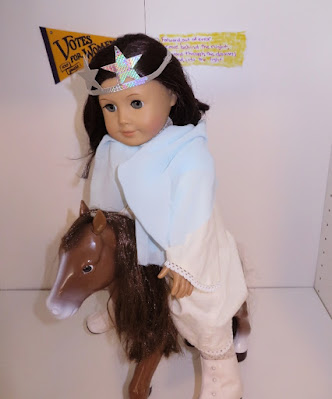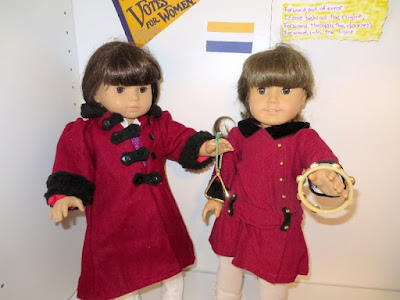All about me, Susanna, the time traveler! I'm a modern girl who travels through time to visit my friends and view historic sites.
Monday, August 31, 2020
Celebrating the 19th Amendment: After the March
Celebrating the 19th Amendment: Time Travel to the Women's Suffrage Parade in 1913
Celebrating the 19th Amendment:
Time Travel to the Women's Suffrage Parade in 1913
Celebrating the 19th Amendment: Time Travel to the Women's Suffrage Parade in 1913
Celebrating the 19th Amendment:
Time Travel to the Women's Suffrage Parade in 1913
Celebrating the 19th Amendment: Time Travel to the Women's Suffrage Parade in 1913
Celebrating the 19th Amendment:
Time Travel to the Women's Suffrage Parade in 1913
At 2 p.m. the Illinois delegation assembled on New Jersey Avenue and Wells was nowhere to be found. The other two ladies who agreed to march with Ida in the separate section, Geraldine Brooks and Belle Squire (co-founders of the Alpha Suffrage Club) went to look for her, but returned to the march without Ida. Ida jumps in and marches with the Illinois delegation mid-way through. You may see more "colored" women in various delegations such as professional groups, women's clubs, sororities and women's clubs. You may also see some on the floats, in the marching bands and other places. [Editor's note: I ran out of energy to change Addy multiple times in one day but look for a women's history month project highlighting specific women in the future.]
Celebrating the 19th Amendment: Time Travel to the Women's Suffrage Parade in 1913
Celebrating the 19th Amendment:
Time Travel to the Women's Suffrage Parade in 1913
Celebrating the 19th Amendment: Time Travel to the Women's Suffrage Parade in 1913
Celebrating the 19th Amendment:
Time Travel to the Women's Suffrage Parade in 1913
Sunday, August 30, 2020
Celebrating the 19th Amendment: Time Travel to the Women's Suffrage Parade in 1913
Women's Suffrage Parade
Pennsylvania Avenue, Washington, DC
March 3, 1913
Brought to you by Susanna and the magical time travel window.
March 3, 1913, the day before Woodrow Wilson's inauguration, the National American Woman Suffrage Association is parading for women's suffrage down Pennsylvania Avenue. Lawyer and activist Inez Milholland leads over five thousand suffragettes up Pennsylvania Avenue, along with over 20 parade floats, nine bands, and four mounted brigades.
Dressed in white to represent the "New Woman" of the 20th-century, she rides astride a white horse, "Grey Dawn."
 |
| Inez Milholland astride Grey Dawn |
“Forward out of error,
Leave behind the night.
Forward through the darkness,
Forward into light!”
The words are meant to evoke the suffrage movement’s goal of a brighter future through women’s votes, and the hope of leaving behind the “error” and “darkness” of oppression.
The first section contains floats that represent countries where women already have full suffrage (Norway, Finland, New Zealand and Australia), Women from the National Association for Women's Suffrage Norway. Norway has just granted women the right to vote in 1913. In 1906, Finland, was the second country in the world to implement both the right to vote and the right to run for office. Finland was also the first country in Europe to give women the right to vote.
The first section contains floats that represent countries where women already have full suffrage (Norway, Finland, New Zealand and Australia), Women from the National Association for Women's Suffrage Norway. Norway has just granted women the right to vote in 1913. In 1906, Finland, was the second country in the world to implement both the right to vote and the right to run for office. Finland was also the first country in Europe to give women the right to vote.
This section also features floats bearing women from countries where women have partial suffrage (Sweden, Denmark, Iceland, Great Britain and Belgium) and countries where women were working for suffrage. Here is a woman from The National Association for Women's Suffrage (Sweden), a part of the International Woman Suffrage Alliance.
Wednesday, April 1, 2020
Women's History Month
My dearest cousin Susanna,
Do you recall, some time ago when I sent you my essay on Ida Tarbell? While I was reading Uncle Gard's copies of McClure's magazine, I discovered some engaging new fiction stories. I learned the fiction editor, Viola Roseboro' is none other than the eccentric lady in the park with the suitcase of paper. Do you remember we were forbidden to speak with her? Well, I had Agnes and Agatha cause a diversion walking Jip in Madison Square Park so I could have occasion to interview Miss Roseboro' about her life.
Viole (Vee-oh-la) Roseboro' (accent intentional) was born in 1858 in Pulaski, Tennessee. Her family moved away just before the Civil War because they had abolitionist leanings. They moved around a lot and Viola was a sickly child.
She returned to Tennessee to attend Fairmount College. After college, Viola did not marry. She went on a "reading tour" of the south reciting poems and monologues from Southern literature and in Scotch dialect. Viola dreamed of being on the REAL stage in New York but first she traveled with a stock company. In 1882 she moved to New York and acted in two plays, Two Orphans and The Lights O’ London.
 |
| Viola Roseboro in Two Orphans, a story of the French Revolution Look at the published play... I didn't read it. I'm not sure I'm supposed to know about the French Revolution |
She also worked as a journalist and began publishing short stories in magazines. She published a book of her own stories, Old Ways and New (1892).
Poor health forced Viola to give up the stage in 1887 and turned to literature to make a living. Viola wrote for the The Century, The Cosmopolitan and The Daily Graphic. During this time, Viola started writing her first novel. She became friendly with artists and was hired as a reader at a literary syndicate run by Samuel McClure. He soon hired Viola as his fiction editor when he launched his own magazine in '93.
"Rosie," as she is known at the magazine, is good friends with Ida Tarbell. Rosie has discovered some of the best up-and-coming authors of our day. Rosie corresponds regularly with a writer she assures me will be quite famous some day, O. Henry. Back in '99, she published his first story, Whistling Dick’s Christmas Stocking.
He has now written two books of short stories. I think I read The Gift of the Magi last year, or at least GrandMary gave it to me to read as an "improving work of literature."
Rosie tells me about a new lady writer she is working with, Willa Cather. Miss Cather has published a book of verse, for McClure's, two stories called Paul's Case and The Sculptor's Funeral included in a a collection of short stories called The Troll Garden.
McMcClure just hired Miss Cather to work at the magazine. Rosie assures me the new novel Miss Cather's is working on is terrible but if Miss Cather has the courage to throw it out and try again writing from a different point-of-view, it will be "one of the books of the world". (Susanna's note: My Ántonia. My guardian says I should read it when I'm older. My friend Kirsten's stories were partly inspired by Willa Cather's novels).
To date, Rosie published two more books of her own stories, The Joyous Heart in '03 and Players and Vagabonds in '04.
Rosie is a true eccentric. She does not wear a corset and loves slouchy clothes, smokes cigarettes and hates working in the office. She often brings a suitcase of manuscripts to Madison Square Park and sits on a park bench to read.

She eats mostly raw food and carries around a bottle of water.
Rosie can be very blunt and rude sometimes but I rather enjoyed my conversation with her.
Thank you cousin Susanna for reading my long letter. I hope to see you soon, perhaps Easter?
Your cousin,
Samantha
Sunday, March 22, 2020
Women's History Month
Ida Tarbell
journalist, crusader, citizen reporter
Ida's career with McClure's came to an end in 1906 when the staff walked out. They were worried about Mr. McClure's morals. She helped buy The American Magazine and focused on writing about what was right. Ida became Associate Editor and stayed there until 1915 after the magazine was sold. |
| Ida Tarbell : citizen report hard at work |
With the money from her book, Ida purchased a farm in Easton, Connecticut. She liked to go there to get away from the city. She also liked to stay there and write. Eventually, she retired to the farm.
 |
| Ida Tarbell on her farm |
Ida Tarbell's History of Standard Oil was such a success that people were outraged. In 1911 The Supreme Court declared Standard Oil was a monopoly which was against the law. They had Standard Oil broken up into smaller companies and Mr. Rockefeller's reputation was damaged. Ida became known as the woman who took down Standard Oil. Even so, Mr. Rockefeller was earning even more money than ever before. Ida was disappointed. She hoped to see Rockefeller out of business.
Ida became very busy with reforms. She wrote a new series of articles criticizing high protective tariff, traveled to Chicago to investigate their public transportation and stayed at Hull House with Jane Addams in 1908. They taught immigrants, like my friend Anita, how to speak English and gave them job and homemaking skills.
 |
| Ida Tarbell, reformer, visits Hull House |
Ida traveled around the United States meeting with factory owners, workers and their families helping women who didn't have a choice but to work. (Like Samantha's friend Nellie). Ida investigated what factory owners were doing to make their workers' lives easier and safer. She wrote about workplace safety and factory conditions in the 1910s and teens.
 |
| Immigrant |
In January 1915, Ida Tarbell published her findings in a series she titled Sticking to the Old Ways: the Golden Rule in Business A Story of Some Recent Dramatic Events. One of the photos is a Slav mother, one of many immigrants interviewed for the piece. Ida found immigrant families were living on $1.60 a day and still managed to save a bit and send their children to school when they were thrifty.
 |
| factory girl (the real mill was unavailable at this time) |
One thing Ida Tarbell was NOT interested in was women's suffrage. Don't tell Samantha! She'll be crushed! Ida did not like the militant movement of the 1910s. She called it anti-male. She may have worried women would lose the power to do good works. Ida wrote a bunch of anti-suffrage essays and collected them in a book called The Business of Being a Woman. It was not a success.
 |
| Ida Tarbell was an anti! |
After women won the right to vote in 1920, she changed her mind.
During World War I, Ida served on the Women's Committee of the Council of National Defense. The organization worked to help women on the homefront. They encouraged women to plant vegetable gardens, dry and can food, knit, sew and make bandages. They also opened daycare centers for factory women.
 |
| Wrong war, same information: can your food |
After the war Ida continued writing and social work. She helped working women by suggested a shorter work day. She wrote one novel, a biography and many more articles. She even wrote an autobiography, All in a Day's Work, in 1939 when she was 82.
Ida Tarbell lived all the way to World War II! She died on January 6, 1944 in Bridgeport, Connecticut. Since her death, Ida Tarbell has received many awards and honors. She helped invent modern journalism.
 |
| Miss Tarbell Before the Industrial Commission, American Magazine, Vol. 79, p. 6, 1915. |
We hope you enjoyed our presentation and learned a lot. Thank you!
Samantha & Susanna







































